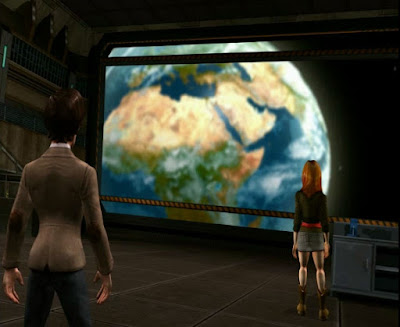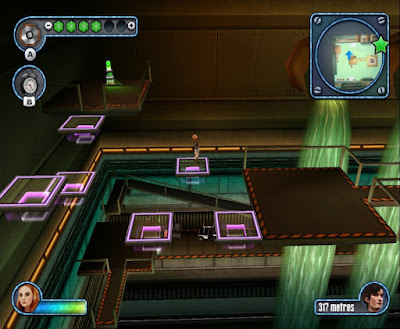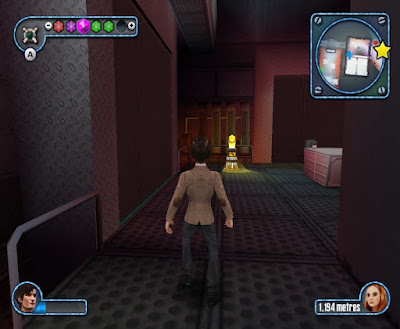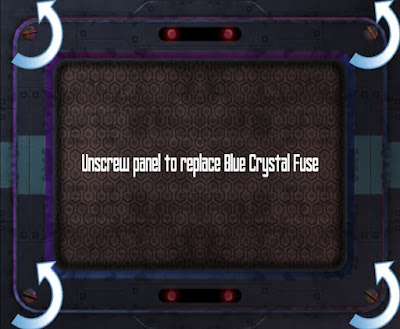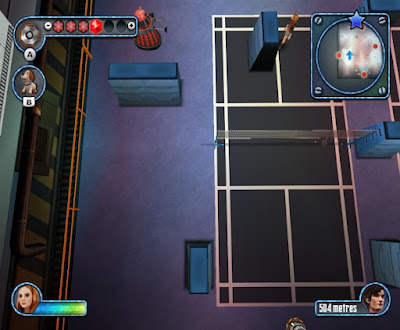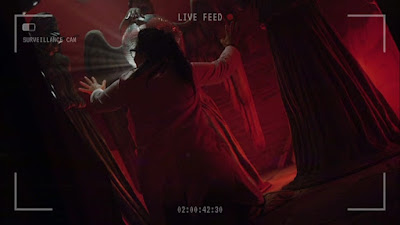 |
| Osgood (Ingrid Oliver) is attacked by Weeping Angels. |
Release Date: Mar. 19, 2021. Written by: Amelia Chung, Priya Kulasagaran, Rebecca Hee, Gavin Collinson. Designer: Jeremy Ooi. Producer: James Baines. Released by: Maze Theory. Version Played: Nintendo Switch.
THE PLOT:
After finding a lost phone, you receive a call from Petronella Osgood (Ingrid Oliver), scientific advisor to UNIT. The phone's owner, Larry Nightingale (Finlay Robertson), has gone missing, and Osgood enlists your aid in scouring his phone for clues about what happened.
Browsing through his email, chats, gallery, and search history reveals hints about what he was investigating. Larry's new neighbor, the thoroughly unpleasant Edward Flint (Ceri Mears), had purchased the Wester Drumlins estate - the spooky old mansion in which Larry and his friend Sally Sparrow had trapped Weeping Angels many years prior. Flint was renovating the old house, and Larry worried that the structural changes might free the statues from their captivity.
The disappearances of Larry and his wife already indicate that something very bad has happened. As you scroll through the phone, you discover garbled data - a virus of some sort. Osgood recites the Doctor's warning that anything that captures the image of an angel becomes an angel... including a phone that was used to take pictures and video.
The Weeping Angels have contaminated Larry's phone. And through that phone, they may now be coming for you!
 |
| Larry Nightingale (Finlay Robertson) prepares to face the Angels. |
CHARACTERS:
The player character is a complete self-insert, never named and never seen on screen. You are allowed to shape a bit of personality through optional conversation responses, though, with the game developers even allowing you the ability to hang up on people or ignore incoming calls. I hung up on Osgood in the introductory phone call and got an indignant text as a reply, which I thought was an amusing touch. Actual freedom is limited - refuse Osgood's plea to get involved too many times and you end the game before it properly starts, and the story is 100% on rails. Still, various moments let you react with enthusiasm, fear, or snark, which aids with immersion.
The two characters who get the most attention here are Larry and Osgood. The script gives a decent sketch of how Larry has progressed since the events of Blink, from turning the store he and Sally ran into a successful business to settling down with a woman who shared his love of old TV shows and movies. Sally herself is MIA, which is unsurprising given the trajectory of Carey Mulligan's career, but at least the game mentions the character in text messages.
Osgood is your main point of interaction, with you exchanging texts with her throughout the investigation and, at the climax, viewing through security camera feeds as she faces the Angels directly. The character remains engagingly quirky, and the oddball aspects are kept mostly low-key to avoid interfering with the suspenseful tone of the piece. Jodie Whittaker's Doctor also gets a voice cameo and another, quick post-credits line if you unlock the game's "best" ending, which helps to make this feel authentically a part of the series.
 |
| The Angels infect the phone and inflict an obscure puzzle on you! |
GAMEPLAY:
If you saw either the movie Searching or its spinoff, Missing, then you have a fair idea of what to expect here. The entire game is you searching through a phone, opening and downloading files, following links, and at one point hacking a set of security cameras. It's basic but reasonably involving, particularly when the tension starts to rise around the midpoint.
There are a couple of puzzles, one of which ("Moth to a Flame") is so obtuse that I doubt many solved it without benefit of a walkthrough. There are also points at which you have to enter information from emails or texts, and the game fails to provide either a "Copy/Paste" function or even a "Memo" function to take notes - both of which are functions that an actual cell phone would have! Instead, you get to relive the CRPG days of yore, having to jot down notes on paper to use later.
Outside of that, gameplay is fairly straightforward and not at all difficult. Even if you fail a timer at one point (as I did when I couldn't figure out the "Moth" puzzle), it's not a "Game Over," though it will lock you out of the best ending.
 |
| Data corruption infests Larry's phone and slows the investigation. |
THOUGHTS:
The Lonely Assassins is a direct sequel to the classic episode, Blink, and it basically acts as its own "Doctor-lite" episode. It's also a better "found footage"-style Doctor Who than Sleep No More was, using both the interactive elements and the restriction of action to the phone screen in ways that increase both tension and immersion.
Like Maze Theory's earlier The Edge of Time, this is a short game. If you have a free morning, you could pretty easily play this through in one sitting. Unlike their previous title, though, the short length feels right for the story. It's nicely structured. At first, it's relaxed, even a bit slow. You're essentially poking around Larry's phone, piecing together the current state of his life. You receive prompts via an app Osgood planted on the phone, which alerts you when you find evidence to send to her.
Once you upload a certain amount of evidence, Osgood uses what you've provided to unlock hidden files and data. Then you go back through the phone, with the newly unlocked files drawing you into the next layer of the story. On a gameplay level, this loop is repetitive, and it doesn't really change until the last part of the story. On a narrative level, though, it's very effective, with each new iteration filling in pieces of what happened to Larry and what's happening at Wester Drumlins. The player character is eventually put into danger - but the story had me hooked well before that point. It helps that, while it's clearly a lower-budget title, both production values and performances are on par with the television series.
Though I enjoyed this, I do have a few nitpicks. I already mentioned the lack of ability to either type in memos or copy and paste, which would have made the relatively simple puzzles feel more realistic and less "game-like." I'm also not personally a fan of having the Angels taunt the characters. I know this was also done in television episodes such as The Time of Angels and Village of the Angels - but both of those were more artful in the taunting scenes, using it to build characterization, whereas the Angels' sing-song threat of "Petronella goes to hell-a" just sounds like the jibes of a high school "mean girl."
 |
| A phone call from the Doctor helps to make this feel like an authentic "Doctor-lite" episode. |
OVERALL:
It's a sadly low bar, but The Lonely Assassins is easily the best story-driven Doctor Who game I've played to date. It's well-scripted, with a careful story structure that uses the interactive elements both to advance the plot and to draw the player in. Performances are good, with Ingrid Oliver's Osgood as winning as ever, and the Angels remain an unsettling presence, even if I could personally live without the taunting.
It's available fairly cheaply (as of this writing, Steam has it listed for under $10), and it provides a good three hours of entertainment while doubling as a solid "Doctor-lite" episode in its own right. If the "found phone" format holds any appeal to you, I think the odds are good that you'll get enough entertainment value to justify the purchase.
Overall Rating: 7/10.
Preceded by: Revolution of the Daleks
Followed by: The Halloween Apocalypse
13th Doctor Video Game Reviews
Doctor Who Video Game Review Index
To receive new review updates, follow me:
On BlueSky:
On Threads:



